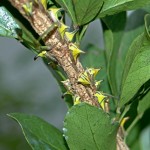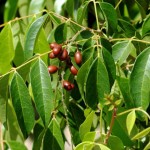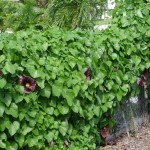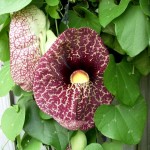Remember the Thorn Birds, by Colleen McCullough? Australian novel that got turned into a miniseries here in the States? I don’t. I wasn’t allowed to stay up late enough to watch it when it came out, and now I don’t really care too much to track it down and find out whether I’ve missed something or not. And why bother? I have all the drama I need right here in my backyard in Boca. Of course, you have to look a bit more closely; this is not the wide-open sweep of the Outback (even though it is, technically, out back).
The drama, in this case, comes from a minor infestation of thorn bugs that Marcella noticed as she and I were carting the boy around for our wish-it-were-daily but it’s more like weekly backyard promenade. The thorn bug (hence the opening reference to thorn bird), Umbonia crassicornis, really is exactly what its common name says it is: a bug that looks like a thorn. A true bug, that is, a member of the order Hemiptera, with piercing sucking mouthparts (there are about 29 orders of “bugs,” not counting arachnids and the cockroaches of the sea, lobster–did you know that there was an early union effort in Massachussetts in the 19th century that required people not to make their servants eat lobster more than three times a week, because it was inhumane? Lobsters are the marine equivalent of the roach: bottom-dwelling scavenger par excellence. Neither one is a true bug, though.). Anyway, here, in case you’re curious, is what an infestation of thorn bugs looks like:

According to my National Wildlife Federation Field Guide to Insects and Spiders of North America, the Thorn Bug ranges from southern Florida south to South America. It apparently holds orgies on ornamental plants, “especially members of the pea family.” And guess what? Arthur V. Evans knows his stuff: these little beasties are holding forth on my Blackbead (Pithecellobium keyense), a member of the Leguminosae (peas to you and me).
The other theory I harbor to explain this infestation is that these little guys are critics of habitat suitability. Theoretically, the Blackbead isn’t supposed to be found north of the Keys, but my landscape designer (Lorax designs) has a soft spot for more-southern species–I also have Bitterbush (Picramnia pentandra), which according to Gil Nelson is found only in “hammocks and sandy soils of Dade County,” and Crabwood (Ateramnus lucidus), which is restricted to “hammocks of the extreme southern peninsula and the Keys.”

As we continued our tour, we ran across what are probably the last crops of Polydamas swallowtail caterpillars on our Aristolochia vine (Dutchman’s pipe). This vine is absolutely swarming all over our chain link fence, and frankly, we need a few more good butterflies to help eat it back:

It’s taking over our Black Ironwood (Krugiodendron ferreum), which has the distinction of being the heaviest, densest wood in North America, if not the world. It will sink in sea water. If you recall our lesson from the FMNP the other day, hammock plants have evolved two basic strategies for dealing with hurricanes: one, followed by the Gumbo-Limbo (Bursera simaruba) and the Paradise Tree (Simarouba glauca), is to be extremely brittle, so that the strong winds we get every decade or three may knock your branches off, but that downed wind can resprout and actually spread your “seed” around. The other strategy is the one evolved by the Black Ironwood: just grow so dang hard that no wind short of Category 5+ is going to knock you down.
Anyhoo, here’s a picture of one hungry caterpillar munching its way contentedly through a tiny part of our massive Dutchman’s Pipe:

By the way, if you haven’t seen a Dutchman’s Pipe blossom, they’re truly spectacular; despite the tendency to dominate an area, I would highly recommend adding this vine to your garden. It’s a great draw for Polydamas butterflies, and if you add a couple of other vines, like our native passionflower vine (Passiflora suberosa), you can attract three more fabulous species: two heliconians, the Julia and our state butterfly, the Zebra, and the spectacular Gulf Fritillary. I suspect that our yard has had all three of these species, although the fritillary and the zebra are far more frequent visitors than the Julia.
Oh yeah, before I forget–here’s the Dutchman’s pipe flower. Very showy, n’est-ce pas?

Caterpillars, and their adult forms, butterflies and moths, comprise the order Lepidoptera. They are not true bugs, like the thorn bug. But they are pretty, and interesting, and important denizens of the world of the backyard. And that, my friends, is how we get from the Thorn Birds in the Outback to the thorn bugs out back.
UPDATE: Re Lobsters, I should have linked to David Foster Wallace’s essay, Consider The Lobster, even if he hadn’t been in the news recently for his rather sad demise.
